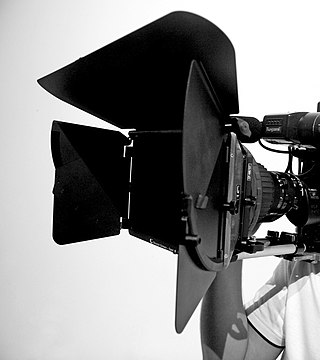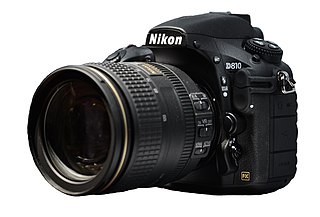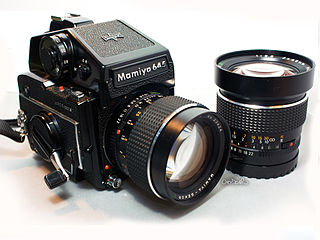
Steadicam is a brand of camera stabilizer mounts for motion picture cameras invented by Garrett Brown and introduced in 1975 by Cinema Products Corporation. The Steadicam brand was acquired by Tiffen in 2000. It was designed to isolate the camera from the camera operator's movement, keeping the camera motion separate and controllable by a skilled operator.
Cinema Products Corporation was an American manufacturer of motion picture camera equipment.

In photography and videography, a matte box is a device attached to the end of a lens in order to prevent light leakage. It performs and mounts essentially the same as a lens hood, but usually includes adjustable fins called French flags.

The Micro Four Thirds system is a standard released by Olympus Imaging Corporation and Panasonic in 2008, for the design and development of mirrorless interchangeable lens digital cameras, camcorders and lenses. Camera bodies are available from Blackmagic, DJI, JVC, Kodak, Olympus, OM System, Panasonic, Sharp, Logitech Mevo and Xiaomi. MFT lenses are produced by Cosina Voigtländer, Kowa, Kodak, Mitakon, Olympus, Panasonic, Samyang, Sharp, Sigma, SLR Magic, Tamron, Tokina, TTArtisan, Veydra, Xiaomi, Laowa, Yongnuo, Zonlai, Lensbaby, Venus Optics and 7artisans amongst others.

The Nikon D90 is a 12.3-megapixel digital single-lens reflex camera (DSLR) model announced by Nikon on August 27, 2008. It is a prosumer model that replaces the Nikon D80, fitting between the company's entry-level and professional DSLR models. It has a Nikon DX format crop sensor.
Articles related to the field of motion pictures include:

The Arri Alexa is a digital motion picture camera system developed by Arri. The Arri Alexa was introduced in April 2010 and was Arri's first major transition into digital cinematography, after previous efforts including the Arriflex D-20 and D-21.

The Nikon D5100 is a 16.2-megapixel DX-format DSLR F-mount camera announced by Nikon on April 5, 2011. It features the same 16.2-megapixel CMOS sensor as the D7000 with 14-bit depth, while delivering Full HD 1080p video mode at either 24, 25 or 30 fps. The D5100 is the first Nikon DSLR to offer 1080p video at a choice of frame rates; previous Nikon DSLRs that recorded 1080p only did so at 24 fps. It replaced the D5000 and was replaced by the D5200.

The Canon Cinema EOS autofocus digital photographic and cinematographic SLR and mirrorless interchangeable lens camera system was introduced in late 2011 with the Canon EOS C300 and followed by the Canon EOS C500 and Canon EOS 1D C in early 2012.

The EOS C100 is a digital cinema camera made by Canon, announced on August 29, 2012. It was the third camera from the Canon Cinema EOS line to be released, and is the budget camera in the range, being less expensive than both the EOS C300 and EOS C500, going on sale at a recommended price of $7,999. However, unlike the other models, it only shoots in Full HD.

The Nikon D810 is a 36.3-megapixel professional-grade full-frame digital single-lens reflex camera produced by Nikon. The camera was officially announced in June 2014, and became available in July 2014.
Freefly Systems is an American corporation that designs, manufactures, and markets camera movement systems and camera stabilizers used in cinematography including unmanned aerial vehicles for aerial cinematography, gimbals, and remote controlled vehicles. The company headquarters are in Woodinville, Washington.

The Ciné-Kodak Special (CKS) family of precision, versatile, spring-wound 16 mm silent movie cameras were produced by Eastman Kodak from the 1930s to the 1960s; while the regular Ciné-Kodak 16 mm movie cameras were marketed to amateurs, the Ciné-Kodak Specials were intended for advanced consumers and industry professionals.
The Blackmagic URSA is a digital movie camera developed and manufactured by Blackmagic Design, released on August 8, 2014. It is the first camera to be user-upgradeable for additional equipment manufactured by Blackmagic and other third-party makers.

The Mamiya 645 camera systems are a series of medium format film and digital cameras and lenses manufactured by Mamiya and its successors. They are called "645" because they use the nominal 6 cm x 4.5 cm film size from 120 roll film. They came in three major generations: first-generation manual-focus film cameras, second-generation manual-focus film cameras, and autofocus film/digital cameras.

The Sony Xperia 1 III is an Android smartphone manufactured by Sony. Designed to be the new flagship of Sony's Xperia series, the phone was announced along with the compact flagship Xperia 5 III and the mid-range Xperia 10 III on April 14, 2021.

The Sony Xperia 1 IV is an Android smartphone manufactured by Sony. Launched on May 11, 2022, it succeeds the Xperia 1 III as the latest flagship of Sony's Xperia series. The device was announced along with the mid-range Xperia 10 IV, with expected release dates by June 2022 and as late as September 2022 for other markets including the US. US shipments were delayed and ultimately began in late October 2022.
DJI Ronin is a series of motorized camera stabilization gimbals and digital movie cameras manufactured by DJI, a Chinese drone manufacturer.
The Sony FX6 (ILME-FX6) is a full-frame mirrorless, interchangeable-lens, semi-professional cinema camera announced on 17 November 2020. The model is positioned between the smaller Sony ILME-FX3 and larger Sony PXW-FX9.













